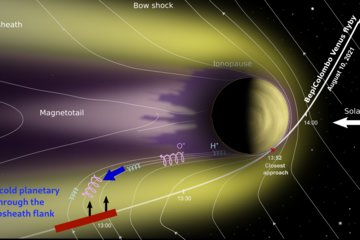All genres
61.
Journal Article
Radiative magnetohydrodynamic simulation of sunspot structure. Astrophysical Journal 691, pp. 640 - 649 (2009)
62.
Journal Article
Der Aktivitätszyklus der Sonne. Astronomie + Raumfahrt 46(6), pp. 28 - 31 (2009)
63.
Journal Article
Simulation of a flux emergence event and comparison with observations by Hinode. Astronomy and Astrophysics 507, pp. L53 - L56 (2009)
64.
Journal Article
Comparison of the thin flux tube approximation with 3D MHD simulations. Astronomy and Astrophysics 504, pp. 595 - 603 (2009)
65.
Journal Article
A robust correlation between growth rate and amplitude of solar cycles: consequences for prediction methods. Astrophysical Journal 685, pp. 1291 - 1296 (2008)
66.
Journal Article
Solar Surface Emerging Flux Regions: A Comparative Study of Radiative MHD Modeling and Hinode SOT Observations. Astrophysical Journal 687, pp. 1373 - 1387 (2008)
67.
Journal Article
The intensity contrast of solar granulation: comparing Hinode SP results with MHD simulations. Astronomy and Astrophysics 484, p. L17 (2008)
68.
Journal Article
Strong horizontal photospheric magnetic field in a surface dynamo simulation. Astronomy and Astrophysics 481, pp. L5 - L8 (2008)
69.
Journal Article
Solar Cycle Prediction Using Precursors and Flux Transport Models. Astrophysical Journal 659, pp. 801 - 811 (2007)
70.
Journal Article
Radiative MHD simulations of solar pores. Astronomy and Astrophysics 474, pp. 261 - 272 (2007)
71.
Journal Article
The origin of the reversed granulation in the solar photosphere. Astronomy and Astrophysics 461, pp. 1163 - 1171 (2007)
72.
Journal Article
Magnetic flux emergence in granular convection: radiative MHD simulations and observational signatures. Astronomy and Astrophysics 467, pp. 703 - 719 (2007)
73.
Journal Article
Flow instabilities of magnetic flux tubes - II. Longitudinal flow. Astronomy and Astrophysics 469, pp. 11 - 17 (2007)
74.
Journal Article
Magnetic flux transport on active cool stars and starspot lifetimes. Astronomy and Astrophysics 464, pp. 1049 - 1057 (2007)
75.
Journal Article
Are solar cycles predictable? Astron. Nachrichten 328, pp. 1087 - 1091 (2007)
76.
Journal Article
Flow instabilities of magnetic flux tubes I. Perpendicular flow. Astronomy and Astrophysics 463, pp. 23 - 29 (2007)
77.
Journal Article
Stokes diagnostics of simulated solar magneto-convection. Astronomy and Astrophysics 469, pp. 731 - 747 (2007)
78.
Journal Article
A solar surface dynamo. Astronomy and Astrophysics 465, pp. L43 - L46 (2007)
79.
Journal Article
A necessary extension of the surface flux transport model. Astronomy and Astrophysics 446, pp. 307 - 314 (2006)
80.
Journal Article
Moving magnetic tubes: fragmentation, vortex streets and the limit of the approximation of thin flux tubes. Astronomy and Astrophysics 451, pp. 303 - 317 (2006)











